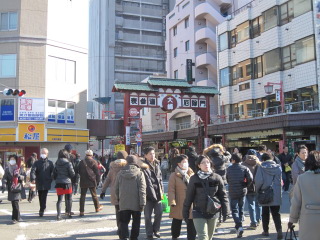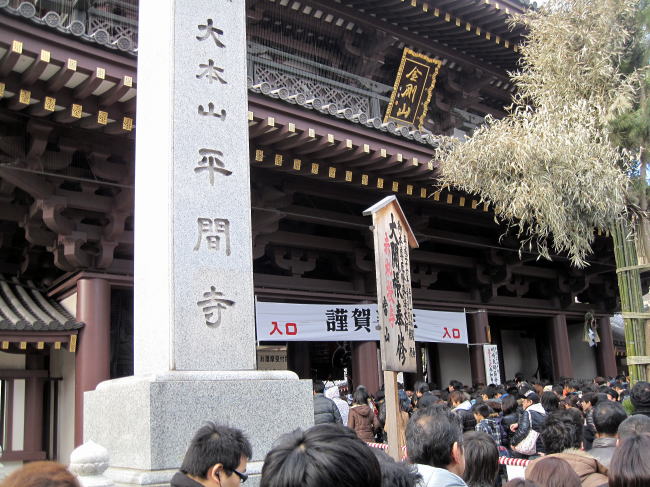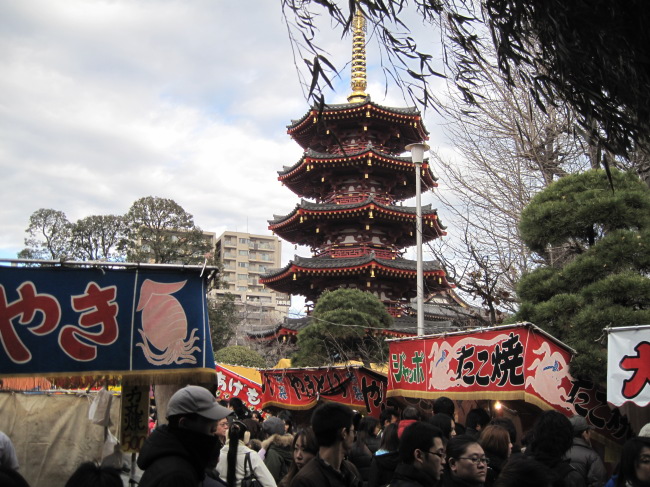Weekly Topics/Archive
January 2013
|
| Hatsumoude�@�@�@�@�@�@�@�@�@�@�@�@�@�@�@�@�@�@�@�@�@�@�@�@�@�@�@�@No.183�|Jan.3, 2013 |
�@�@I attended the Hatsumoude with my wife after a long interval.
Hatsumoude means New Year's visits to shrines or temples in order to pray
for things such as
health for one's family and prosperity in business.
Speaking of the Hatsumoude, my family generally used to visit Gumyo-ji
temple nearby.
This is the year of the snake in the Chinese zodiac, so I broke away from
the long-held custom
and decided to visit Kawasaki Daishi temple in Kawasaki City.
The only shrine or temple to which I have made a New Year's visit is Turugaoka
Hachimangu
Shrine in Kamakura.
It is the first time I visited Kawasaki Daishi temple.
�@Later I found out that it took third place in the ranking of visitors for the first three days of New
Year in 2012.
Just like such a temple, it was very crowded with many visitors.
When we walked toward Dai-Sanmon (main gate) with the flow of people from
Keikyu Kawasaki-daishi station, we could see a lot of B-grade grourmet
stalls which lined the street
tightly.
( B-grade gourmet is a type of Japanese food. �@�gB-grade�h means second rate,
and �ggourmet�h
means delicious food in this case. �@Its characteristics are popularity
and cheapness.)

The square in front of Kawasaki Daishi station
which is crowded with visitors
to Kawasaki Daishi temple |
|
|

A lot of B-grade gourmet stalls on the street
|
|
�@It took about 40 minutes to get to the main gate because of a traffic regulation
caused by congestion during New Year holidays.

The main gate, Dai-sanmon of Kawasaki Daishi temple |
�@It took about 10 more minutes to get to the main hall at the front from
the gate.

The main hall, Dai-Hondo of Kawasaki Daishi temple |
�@At the hall, I prayed for happiness and a healthy year.
Happy New Year to all!
�@By the way, Kawasaki Daishi is formally called Heiken-ji temple.
It is the headquarters of the Chizan sect of Shingon Buddhism.
And also it has been worshipped as Kobo Daishi for protection from evil
since old times.
�@The temple complex was destroyed by fire during World War �U.
Many of temple buildings are reconstructed of steel and concrete.
And so, I felt they are something different compared to old temples in
Kyoto, Nara and Kamakura.
We have to accept the inevitable, don't we?
In another 500 years from now, the temple will fall into the category of
old temple.
�@I was surprised when I looked over the temple grounds from the main hall.
The lanes in the temple were lined with a lot of stalls selling B-grade
gourmets, souvenirs,
snacks and drinks.
It is the first time for me to see a temple like that.

The stalls and the octagonal five-story pagoda in the temple |
|
�@It looked like a commercial Buddhist temple personified for me.
The temple is a religious corporation.
In the articles of incorporation of this temple, the rental of the temple
ground may also be
included as one of the business.
�@The religious corporation might be non-profitable organization.
Off course, I never deny that it makes money for Buddhist activities.
�@However, when I see these scene, I can't help feeling that it's excessive
activity.
I hope that Kawasaki Daishi will keep the dignity as the temple.
But Chishaku-in temple in Higashiyama, Kyoto, which is the head temple
of the Chizan sect of Shingon Buddhism, is a temple with the dignity.
If Kobo Daishi (Kukai), the founder of the Shingon Buddhism, saw it, how
would he feel ?
So, how do you feel about that ?
�@We stopped at a soba restaurant on Nakamise street on the way home.
I drank hot sake and ate kaiun soba noodles to warm myself up.
�@��The date of the taking of the photos �G Jan.03,2013��
[Note]�@attend the Hatsumoude �G ���w�ɍs���A�@speaking of �`�G�`��(�ɂ���)������
�@year of the snake in the Chinese zodiac�G(���x��)���N
�@ break away from �`�G�`����E�p����, (�K���Ȃǂ�) ��߂�
�@just like �`�G�������́`����������, Dai-Sanmon (main gate)�G��R��
�@B-grade groumet �GB ���O����, stall �G�I�X, line the street �G�ʂ�ɗ�������
�@second rate�G��,traffic regulation�G�ʍs�K��, congestion�G ���G
�@the Chizan sect of Shingon Buddhism�G�^���@�q�R�h,Kobo Daishi �G�O�@��t
�@ protection from evil�G���, worship �G ���q����
�@ temple complex�G���̌����Q, be something different ; ������قȂ�
�@be constructed of steel and concrete�G�S�R���N���|�g����ł���
�@accept the inevitable�G��ނȂ��Ƃ�����߂�
�@in another �` years from now�G���Ɓ`�N�������
�@ fall into the category of �`�G�`�̔��e�ɓ���,�@look over �`�G�`�����n��
�@be lined with�`�G�`������A�˂�,�@octagonal�G���p�`��
�@ five-story pagoda�G�d��,�@�`(����)�{personified�G�`�̌���
�@articles of incorporation�G �芼, Buddhist activity�G ��������
�@can't help feeling that �`�G�`�Ƃ����C�����ĂȂ�Ȃ�, dignity�G �i�i
�@warm oneself up�G �̂����߂�
�@Japanese Diary / No.504�|2013.01.03 / �u���w���v Diary / No.504�|2013.01.03 / �u���w���v
�@�@�@�@�@�@�@�@�@�@�@�@�@�@�@�@�@�@�@�@�@ TOP�y�|�W�֖߂� TOP�y�|�W�֖߂�
|
|